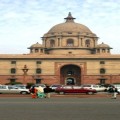The Parliament House Estate comprises the Parliament House, Reception Office Building, Parliament House Annexe, the Parliament Library Building, and the extensive lawns around it where ponds with fountains have been provided. The entire Parliament House Estate is enclosed by an ornamental red sand stone wall or iron grills with iron gates.
The Parliament House commonly known as the Sansad Bhavan is a circular building which was designed by the British architects Sir Edwin Lutyens and Sir Herbert Baker in 1912–1913. It is one of the most magnificent buildings in Saddi Dilli which has one of the brightest clusters of architectural gems possessed by any country in the world. The construction of our Parliament House began in 1921, and in 1927 the building was opened as the home of the Council of State, the Central Legislative Assembly and the Chamber of Princes.
The dome of the Parliament House is 27.4 meters high and the Parliament House is spread over 2.02 hectares. The roof of the outer circle of the structure is supported by 247 granite pillars. The Parliament House is situated at the end point of the Sansad Marg, close to the former Viceroy’s House which is today’s Rashtrapati Bhavan and it is also visible from the India Gate. The former Chamber of Princes was home to the Supreme Court of India until 1958.
The Central Hall of the Parliament House has been a witness to many historic events. The Central Hall, located at the centre of the circular Parliament House, is surrounded by three Chambers and three well laid-out courtyards with lush green lawns and fountains. There are short passages radiating from three equidistant points on the circumference of the Hall connecting with the Lok Sabha Chamber, the Rajya Sabha Chamber and the earlier Library Hall.
It was in this Central Hall that India began its tryst with destiny on the midnight of 14-15 August 1947. Our Constituent Assembly which framed the Constitution of India met in this very Hall. One finds it adorned with portraits of eminent national leaders whose memories we dearly cherish. The President of India addresses members of both Houses of Parliament assembled together in this Hall which is also used for other ceremonial occasions. When the Parliament is in session, the Central Hall is used by members of Parliament as a common lobby for informal discussions among themselves.
General public is allowed to enter the Sansad Bhawan or the Parliament House and view sessions in the public gallery by receiving permits from the reception office of Raisina Road of New Dilli. Entrance to the Parliament House requires a letter of introduction which is a form of official permission. Indian citizens can apply to the secretariat of the Parliament for this permission while foreigners can apply for permissions to their respective embassies or high commissions.
The Parliament House has a central library whose working hours are from 10 am to 6 pm. The Parliament House of India is a place where the world’s largest democracy functions. Though photography is not prohibited inside the Parliament House, prior permission is required if one plans to take pictures.




Leave a Reply